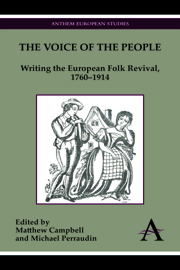Book contents
- Frontmatter
- Table of Contents
- List of Figures
- Introduction
- Chapter 1 The Impact of Ossian: Johann Gottfried Herder's Literary Legacy
- Chapter 2 On Robert Burns: Enlightenment, Mythology and the Folkloric
- Chapter 3 The Classical Form of the Nation: The Convergence of Greek and Folk Forms in Czech and Russian Literature in the 1810s
- Chapter 4 Literary Metamorphoses and the Reframing of Enchantment: The Scottish Song and Folktale Collections of R. H. Cromek, Allan Cunningham and Robert Chambers
- Chapter 5 Thomas Moore, Daniel Maclise and the New Mythology: The Origin of the Harp
- Chapter 6 The Oral Ballad and the Printed Poem in the Portuguese Romantic Movement: The Case of J. M. da Costa e Silva's Isabel ou a Heroina de Aragom
- Chapter 7 Class, Nation and the German Folk Revival: Heinrich Heine, Georg Büchner and Georg Weerth
- Chapter 8 The Estonian National Epic, Kalevipoeg: Its Sources and Inception
- Chapter 9 The Latvian Era of Folk Awakening: From Johann Gottfried Herder's Volkslieder to the Voice of an Emergent Nation
- Chapter 10 From Folklore to Folk Law: William Morris and the Popular Sources of Legal Authority
- Chapter 11 Pioneers, Friends, Rivals: Social Networks and the English Folk-Song Revival, 1889–1904
- Chapter 12 The Bosnian Vila: Folklore and Orientalism in the Fiction of Robert Michel
- Epilogue: The Persistence of Revival
- Bibliography
- Index
- List of Contributors
Chapter 5 - Thomas Moore, Daniel Maclise and the New Mythology: The Origin of the Harp
Published online by Cambridge University Press: 05 July 2012
- Frontmatter
- Table of Contents
- List of Figures
- Introduction
- Chapter 1 The Impact of Ossian: Johann Gottfried Herder's Literary Legacy
- Chapter 2 On Robert Burns: Enlightenment, Mythology and the Folkloric
- Chapter 3 The Classical Form of the Nation: The Convergence of Greek and Folk Forms in Czech and Russian Literature in the 1810s
- Chapter 4 Literary Metamorphoses and the Reframing of Enchantment: The Scottish Song and Folktale Collections of R. H. Cromek, Allan Cunningham and Robert Chambers
- Chapter 5 Thomas Moore, Daniel Maclise and the New Mythology: The Origin of the Harp
- Chapter 6 The Oral Ballad and the Printed Poem in the Portuguese Romantic Movement: The Case of J. M. da Costa e Silva's Isabel ou a Heroina de Aragom
- Chapter 7 Class, Nation and the German Folk Revival: Heinrich Heine, Georg Büchner and Georg Weerth
- Chapter 8 The Estonian National Epic, Kalevipoeg: Its Sources and Inception
- Chapter 9 The Latvian Era of Folk Awakening: From Johann Gottfried Herder's Volkslieder to the Voice of an Emergent Nation
- Chapter 10 From Folklore to Folk Law: William Morris and the Popular Sources of Legal Authority
- Chapter 11 Pioneers, Friends, Rivals: Social Networks and the English Folk-Song Revival, 1889–1904
- Chapter 12 The Bosnian Vila: Folklore and Orientalism in the Fiction of Robert Michel
- Epilogue: The Persistence of Revival
- Bibliography
- Index
- List of Contributors
Summary
On 14 August 1842, the London novelist Charles Dickens wrote to his friend the Cork artist Daniel Maclise from his summer retreat at Broadstairs in Kent, mock-pleading with him to come to the seaside. He reminded him of the bracing nature of the sea air, and the more particular attractions of a bather whom Dickens and his male friends called ‘the Screamer’:
The beauty of the weather, the delicacy of the bathing, the crispness of the sea, and the charms of the Screamer all cry ‘Come!’ her swelling bosom and swelling other B invite you. Come! Come! Come!
The Screamer has been identified by Dickens's editors as either a Miss Collins or a Miss Strivens. According to Fintan Cullen, Maclise admitted in a letter to Dickens's biographer John Forster that she was the model for The Origin of the Harp, a painting exhibited earlier in 1842 in the Royal Academy and later at the great Manchester Art Treasures exhibition of 1857. It is currently in the collection of Manchester City Art Gallery (see Figure 1).
The painting is a pictorial representation of Thomas Moore's song ‘The Origin of the Harp’, first published in the third number of his Irish Melodies in 1810. In this lyric, the harp is described as metamorphosed out of the body and hair of a siren who has been abandoned by her lover. Viewers of the picture in 1842 would know that the harp was the Irish national instrument, indeed the symbol of the nation – even if the picture itself is less than explicit on that national subject.
- Type
- Chapter
- Information
- The Voice of the PeopleWriting the European Folk Revival, 1760–1914, pp. 65 - 86Publisher: Anthem PressPrint publication year: 2012
- 1
- Cited by



